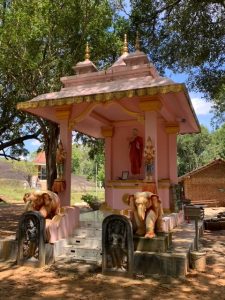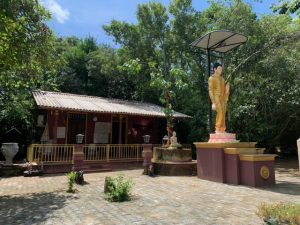
Our visit to Haburugala Aranya Senasanaya, a humble forest monastery tucked away near a jungle and the village of Haburugala in southern Sri Lanka turned out to be an unexpected highlight of our trip.
Arriving under the blazing midday sun, I was struck by how modest the monastery was—a small Dharma hall, a few kutis (monks’ huts), a Buddha statue perched atop a large rock, and a statue of a monk, likely Arahant Mihindu or Mittakala Arahat and some construction work. It was nothing like the larger temples I had imagined, yet its simplicity left a profound impression.
This visit wasn’t originally part of our plan. In fact, it was the donation of Buddha relics by Venerable Sulakhana, the abbot of this monastery, to Tilorien Monastery in Belgium, where I’m connected, and a suggestion from Venerable Vimala, the resident Bhikkhuni, that sparked the idea. They had mentioned that if I ever had the opportunity to visit this monastery, I should report back to them. Initially, I didn’t think it would be possible, as it seemed far from my itinerary. But when the time came, everything fell into place effortlessly. Our driver, Rohan, who is also a Buddhist, assured us that it wasn’t far and could easily be added to our route, despite the mountainous and forested terrain.


While walking around in the monastery, our driver asked some construction workers if it would be possible to speak with a monk, and soon a monk came out. He greeted us and explained to us the setup of the monastery. He said that there are around 26 stupas spread across this jungle region, making it a significant archaeological site. Two stupas had been excavated, and Buddha relics were discovered inside, some of which had been donated to Tilorien Monastery. The monk also mentioned that there are currently eight monks residing at the monastery, though most were away on their alms rounds, so we didn’t have the opportunity to meet Venerable Sulakhana.
As we explored the monastery, I felt the weight of its historical significance—linked to Arahant Mihindu’s foremost student, Mittakala Maharahat, who had enlightened thousands of monks here centuries ago. The peaceful surroundings and the ongoing, quiet construction seemed to reflect the enduring spirit of monastic life in its purest form. Though there wasn’t much to see materially, the deep connection to the Buddha’s teachings made the place feel spiritually significant.

Looking back, what truly struck me was how naturally everything came together. I hadn’t planned much—even the entire trip to Sri Lanka and the 10-day Vipassana meditation retreat idea was sparked by a conversation with Dhamma friends at Tilorien Monastery—yet one event flowed into another without any force. It was a perfect reflection of equanimity, a core Buddhist teaching. Life unfolded on its own, just as it often does when we let go of control and simply observe.
By Upekkhã


 Deutsch
Deutsch Français
Français Nederlands
Nederlands